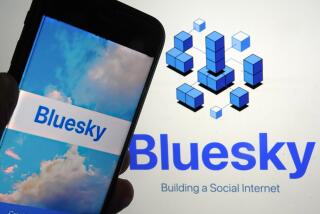‘Ridiculous and amazing’ Slack messaging app keeps human users in mind

Employees work in the San Francisco headquarters of Slack, a company that makes instant messaging apps. According to internal metrics, since its launch in 2014, it has become one of the fastest-growing business applications in history.
Reporting from San Francisco — Slack Technologies Inc. Chief Executive Stewart Butterfield has a theory about why Albert Einstein achieved mainstream popularity while a fellow genius, Austrian mathematician Kurt Gödel, didn’t.
It’s the same reason he thinks his San Francisco’s company’s real-time messaging software, Slack, has become so popular so quickly.
Both Einstein and Gödel accepted positions at the Institute for Advanced Study in Princeton around the same time, and both made significant contributions to scientific and philosophical history. Gödel’s work even made Einstein question his own theories.
“But a lot of people have posters of Einstein on their wall where he’s doing this,” said Butterfield, sticking out his tongue as far as it would go, imitating the now-iconic black-and-white photo of the German physicist.
“No one has posters of Gödel on their wall because he was super-paranoid about people trying to poison him. He was not in any way playful,” Butterfield said. “Einstein was very playful. People like that quality.”
In a sea of drab enterprise software, Slack is the workplace messaging app poking out its tongue.
The mobile and Web-supported app is essentially a feature-packed chat room. Users can send instant messages to groups of co-workers or they can send messages privately.
Slack users can summon GIFs — a kind of animated image — to respond to each other. The software supports customized emojis so people can create their own emoji library with colleagues’ faces and company in-jokes. And Slackbot, the robot that sits in each company’s channels, can be programmed to respond to users — often with a joke; sometimes with sass and attitude.
Those features are why in offices around the world, people don’t just use Slack, they like it. They like it so much that Slack’s astronomical growth has predominantly come from word of mouth, with a groundswell of office workers pushing their organizations from the bottom up to adopt the real-time messaging software and pay for its premium version, which gives companies access to backlog messages and files.
Since its launch in February 2014, Slack has, according to internal metrics, become one of the fastest-growing business applications in history.
As of August, more than 1.25 million people from companies that include the Los Angeles Times, Comcast, NBCUniversal, Expedia and EBay use it every day. That’s a tenfold increase from a year earlier. Even NASA uses it, no surprise -- Einstein posters are popular there.
Slack has received $340 million in funding from venture capital firms such as Andreessen Horowitz and Google Ventures.
Compared with enterprise tech giants such as Microsoft and Cisco, Slack is a small fry. Good luck trying to wrestle millions of companies and millions more users from the incumbents’ Goliath-like hands.
But people are talking about Slack in a way that they don’t talk about the Microsofts and Ciscos of the world.
Ask tech pundits about the secret to Slack, and the words “email killer” often come up. The chat program is one-upping incumbent workplace tools such as Outlook and Gmail at every turn, replacing cumbersome email threads with instant messages, enabling people to share large files without an exchange server in the background whining about size and syncing that information across all devices.
Ask users about the secret to Slack and you get variations on these themes: A likable, personable and relatable quality. Witty without being silly. Delightful while still being practical. Friendly without being overbearing.
Sitting at a conference table, a large digital clock behind him with animal emojis on the face instead of numbers, Butterfield pulled out his iPhone.
“So in the iOS 9 podcast app, every time I hit play, it asks me the weirdest question,” he said, tapping away at his phone. “Before I can listen to my podcast, it asks me if I want to keep it, close it or cancel. I have to do this every time I want to listen to a podcast.”
Butterfield put his phone down as the clock struck monkey o’clock. “I have no idea what ‘cancel’ does,” he said.
Appearing baffled by his own phone, Butterfield said part of creating a likable and delightful experience means removing things like the confusing “cancel” button, which he describes as “anti-delight.”
He asks his designers to perform a simple exercise: to close their eyes and “pretend you’re human.” And then imagine what the average user might have gone through by the time they sit down at their desk. Maybe they were running late and sat in gridlock for an hour. Maybe they had an argument with their spouse. Maybe they’re stressed out.
The last thing they need is to struggle with a computer program that seems intent on making their day worse.
“With Slack, there are so many little moments where you’ve performed an action for the first time and the result is exactly what you expect it to be, and that’s delightful,” said Slack’s design director, Brandon Velestuk.
People shouldn’t be surprised when software works, yet enterprise tech has developed such a reputation for being clunky and uncooperative that when it does work, it’s “refreshing,” said Minh Do, a technical account manager at Internet firm Anchor, whose team started using Slack a month ago. Like many companies, it was the workers in the tech department who discovered Slack and pushed for the rest of the company to use it.
“I think it comes down to two things: simplicity and the number of integrations available,” Do said. “Simplicity in that the chat just works the way you expect, with things like @mentioning and channels working seamlessly,” he said.
Anna Pickard, the company’s editorial director and custodian of Slack’s voice, giggles when she thinks of the oxymoron that is “enjoyable enterprise software.” But she believes that it’s doable, and it lies in the human quality of Slack.
“We’re spending more and more of our time talking to bots and interacting with things where we’re not sure whether they’re real or whether they’re programmed to talk to us,” said Pickard, whose background is in writing and journalism. “So when one of them reacts to us like a human, that’s delightful.”
Keeping the human users in mind, Slack has welcome messages such as, “What a day! What cannot be accomplished on such a splendid day!” and “Sometimes you eat the bear and sometimes the bear, well, he eats you.”
Slack’s release notes — an often-ignored laundry list of technical updates — have become documents littered with puns, jokes and personality.
Companies such as Tumblr, Medium and Annotate have followed suit, writing their release notes as short stories, poems and even sonnets.
Slack’s error message is so amusing that, users often take a screen shot and share it: “… we’ve seen this problem clear up with a restart of your browser, a solution which we suggest to you now only with great regret and self-loathing.”
“It’s ridiculous and amazing, and I think it shows that words are so important,” Pickard laughs. “Words and the way we talk to people are part of what keeps people coming back, it keeps people liking us.”
It all comes back to the Einstein factor. The average person probably couldn’t keep up with the German physicist. The average person probably doesn’t have a lot of love for enterprise software. But there are moments — a cheeky tongue photograph, a warm and funny error message — that people can relate to.
“They can see there are people behind this product, they feel that human connection,” Pickard said. “And through that connection, the whole thing just falls into place.”
Twitter: @traceylien







